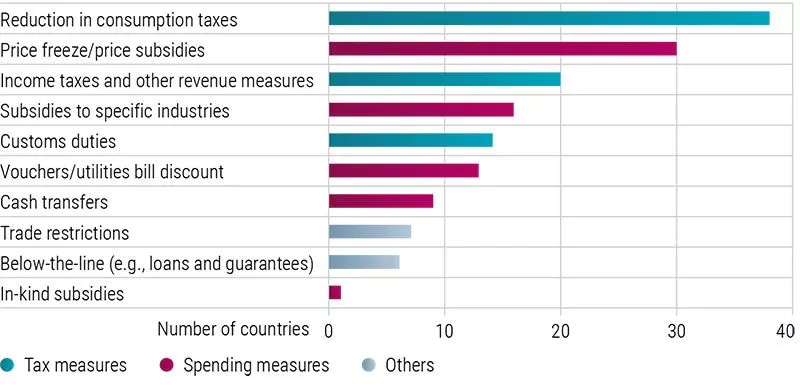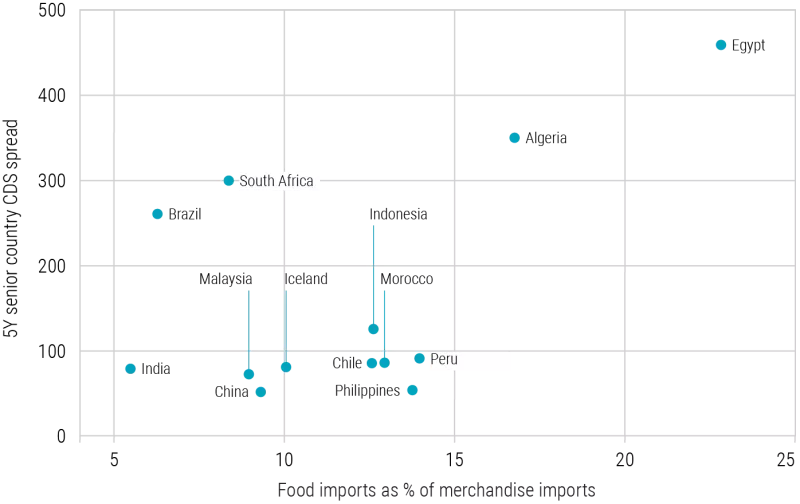Rising food insecurity is unsettling markets and fueling inflation. The global response to it will define emerging financial markets over the next five years, say SI researcher Michal Kulak and strategist Peter van der Welle.
Speed read
- Multiple triggers from weather to Ukraine war have sent food prices soaring
- Consumer discretionary sector likely to be hit as consumer staples benefit
- Long-term winners will be companies providing food security solutions
Rising food insecurity is likely to be one of the key factors driving the volatility of emerging financial markets over the next three to five years. The drivers of food insecurity are complex and range from conflict and political instability to weather extremes and economic shocks. Food price rises provide a significant inflationary push, especially in emerging markets. They also negatively impact global growth, and have been shown to precipitate acute social unrest.
For a multi-asset investor, therefore, monitoring current food prices is key. With the Food and Agriculture Organization’s Food Price Index (FFPI) having risen by 67% since the start of the Covid pandemic, it is also essential to understand the wider impact of food prices on commodities, their relationship with climate change, and the corresponding possible government responses and political instability.
Underlying factors behind the current rise in food prices are varied. Triggered by pandemic hoarding, the rise was exacerbated by a relatively poor harvest season in 2020 and travel restrictions leading to a shortage of foreign workers in key production areas. Post-pandemic recovery then drove up oil and gas prices, which are correlated with the prices of agricultural raw materials.
Fertilizer as a core ingredient
While a shortage of natural gas is often thought of as a heating problem, 25% of global supply is actually used in fertilizer manufacturing. Fertilizer typically accounts for 15-20% of crop production costs, so producing food has rapidly become more expensive, with the world food import bill reaching an historic high in 2021.
In addition, Russia’s invasion of Ukraine has severely affected the food and fertilizer export capacity of both countries, who are major players in this field, creating a perfect storm for further, exponential price increases. Worried about future shortages, several countries including China have begun rebuilding their food reserves, limiting the supply to the global market and creating a vicious circle of further price increases.
The quality of 2022’s northern hemisphere harvesting season will further affect prices. Weather patterns and subsequently crop yields have been increasingly unpredictable in recent years due to climate change. India experienced record heat waves in the spring, resulting in crop failures and wheat export restrictions. A particularly dry, wet or windy summer season in the French Beauce region or the US Corn Belt could complicate the harvest, putting further pressure on prices.
Organic farming won’t help
Organic farming may appear to be an appealing investment proposition because farmers do not use synthetic fertilizers, but it accounts for just 1 to 2% of crop production globally. It also increases, rather than reduces, yield volatility. A switch from grain-based to grass-fed beef in the US would require an additional 23 million cows and a 370% expansion of grassland acreage to 535 million hectares, an area half the size of Canada.
The threat of social unrest is not insignificant though. Food insecurity and “let them eat cake” sparked the French Revolution. In more recent times, a link was established between the last serious food price spike in 2010 and the Arab Spring and Syrian war that followed in 2011.1 The FFPI has been rising since the start of the Covid pandemic, reaching record highs in March 2022. If this trend persists, social unrest may ensue; a hungry population leads to angry voters or potentially insurgency and regime changes.
Measures to combat it
Rising food prices are therefore usually coupled with bold policies designed to keep the situation under control. Typical measures include setting price ceilings, which is bad news for the earnings of food producers; building grain reserves up again; offering tax cuts for foods; implementing trade barriers; and offering subsidies, as illustrated in the chart below.
Source: IMF desk survey based on inputs for 134 countries (responses received as 31 March 2022).
Note: This graphic includes measures announced after 1 January 2022.
All of these instruments are expensive and will provide headwinds to global growth, especially in emerging markets. They will affect current account balances, leading to countries taking on more debt at higher yield spreads. Activist fiscal policy translates into higher inflation volatility and this will subsequently have a negative impact on growth. Slowing growth will depreciate emerging markets' currencies, in some cases mitigated by rising interest rates.
But there are some winners. Those who invest in regenerative, more productive agricultural practices are likely to get ahead, such as agricultural equipment producers that allow the efficient distribution of water, nutrients or pest control with minimum inputs from pesticides. The likely winners also include chemical companies that provide solutions for improving the efficiency of animal feeding, and financial institutions that provide affordable loans to farmers in need.
Consumer discretionary vs. staples
Meanwhile, the consequences of rising commodity prices are already being felt. These are squeezing margins of food, bio-fuel, and bio-based chemical manufacturers, consumer goods companies, and pharmaceuticals. Strong consumer staples brands are better able to pass some of the costs on to the consumer, but as consumer budgets are squeezed, people will switch to cheaper alternatives or reduce the use of products altogether.
The increased spending on basic food over the next few years will substantially reduce the demand for consumer discretionary products and services for low and middle-income consumers. Rising food prices do though favor an equity allocation towards the staples sector over the discretionary goods sector.
For sovereign bonds, the options that governments have to mitigate food crises are costly, as they drive up the fiscal deficit and thereby erode debt sustainability. In response, sovereign bond investors require higher compensation for taking sovereign credit risk in countries that are more vulnerable to food crises. This can be measured by the amount of food imports as a percentage of merchandise imports, as seen in the chart below; Egypt and Algeria are particularly susceptible.
Food imports and 5-year sovereign CDS spreads. Source: Refinitiv Datastream, Robeco
A more hawkish stance
In all, it means elevated food price inflation could therefore lead to international investors demanding higher compensation of inflation riskto invest in emerging market assets, and a more hawkish stance by emerging market central banks in order to contain inflation.
In the long term, improved food security can only be achieved if we shift to a productive agricultural system that can support 9 to 10 billion people within the constraints of one planet. In this way we expect a renewed policymaker focus on sustainable intensification of agriculture and more sustainable and healthy diet trends, creating revenue opportunities for those who provide the solutions.
This article is an excerpt of a special topic in our five-year outlook. Read the full Expected Returns 2023-2027 here.
1 Karla Z. Bertrand, Greg Lindsay, and Yaneer Bar-Yam, Food briefing, New England Complex Systems Institute Report 2012-09-28




